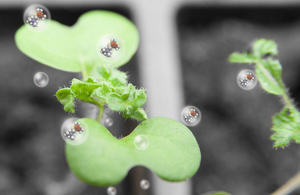Cutting the mustard
A new technique to detect chemical warfare agents using white mustard plants has been developed.

White mustard plant with an artist's impression of molecules superimposed [Picture: Crown copyright]
Following the investigations of the use of chemical warfare agents (CWAs) in Syria last year, the threat of deadly toxic chemicals in conflict is ever more serious.
However, a new technique developed by the University of Central Lancashire (UCLan) and the Defence Science and Technology Laboratory (Dstl), a trading fund of the UK Ministry of Defence, has found a way to detect such CWAs just by using the humble white mustard plant.
In a groundbreaking research project, UCLan and Dstl have shown the white mustard plant can be used to detect previously undetectable levels of nerve agents in CWAs, including the deadly VX agent.
The VX agent is a persistent liquid which is easily dispersed and highly toxic when breathed in or absorbed through the skin.
The research showed that by growing white mustard plants in soil contaminated with VX, the plants would absorb the intact agent and degrade it to chemicals that indicate its presence in the environment, even if it was 45 days since initial contact.
Not only does the white mustard plant detect the agent, but it also helps remove it from the ground. Conventional soil analysis cannot do this, especially not this accurately.

Dr Matthew Baker [Picture: Crown copyright]
Dr Matthew Baker from UCLan’s School of Forensic and Investigative Sciences said:
Currently, the detection of CWAs relies on extraction of signature chemicals from soil, which is sometimes problematic.
The discovery that white mustard plants can successfully absorb the agent from the ground offers a simple but innovative solution to remediate soil contaminated by VX.
Matthew Gravett, a senior analytical chemist from Dstl, added:
The robust data and analytical methods detailed in this study are essential for utilising plants to identify and confirm nerve agent use either as a result of terrorism or conflict.
The simple extraction process vastly improves the ability to discover nerve agent use, and also crucially deters the use of CWAs in future.